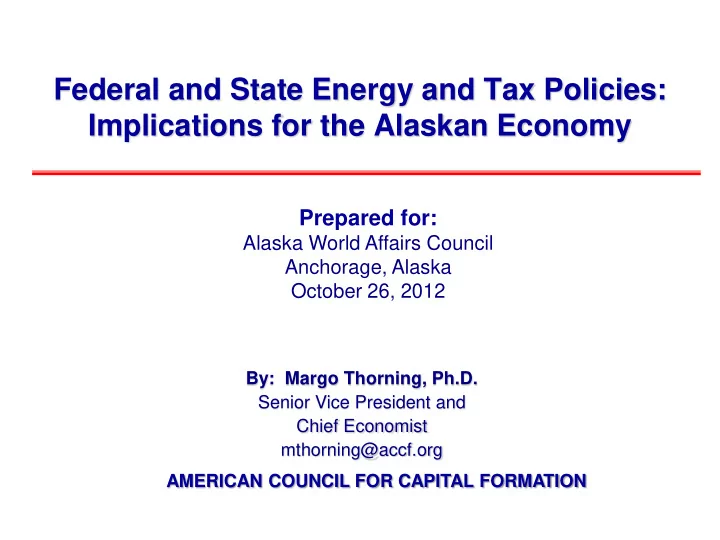

Federal and State Energy and Tax Policies: Implications for the Alaskan Economy Prepared for: Alaska World Affairs Council Anchorage, Alaska October 26, 2012 By: Margo Thorning, Ph.D. Senior Vice President and Chief Economist mthorning@accf.org AMERICAN COUNCIL FOR CAPITAL FORMATION
Federal and State Energy and Tax Policies: Implications for the Alaskan Economy Role of energy in U.S. economic growth Impact of tax policy on new investment Tax reform proposals and energy sector investment
Total Personal Income: Growth from the end of the recession in June 2009 through the first quarter of 2012 Source: “Which States Have Best Income Growth,” The Wall Street Journal, July 16, 2012, http://blogs.wsj.com/economics/2012/07/16/which-states-have-best-income-growth/
Total U.S. Oil and Natural Gas Production (Projected) Source: “U.S. Supply Forecast and Potential Jobs and Economic Impacts (2012-2030),” Wood Mackenzie, September 7, 2011, http://www.api.org/policy/americatowork/upload/API- US_Supply_Economic_Forecast.pdf
Development Policy Case for the U.S.: Incremental Impacts (Change from the Current Path Case) U.S. Impacts 2015 2020 2025 2030 Production (000’s boed) 1,267 4,189 7,937 10,371 Jobs 668,462 1,138,567 1,262,035 1,403,877 Annual Revenues ($Millions) 10,165 27,796 67,613 99,769 Source: “U.S. Supply Forecast and Potential Jobs and Economic Impacts (2012-2030),” Wood Mackenzie, September 7, 2011, http://www.api.org/policy/americatowork/upload/API- US_Supply_Economic_Forecast.pdf
Development Case Assumptions for Alaska Resources offshore Alaska and NPRA are developed ANWR Production begins in 2017 Environmental regulation of shale gas and tight oil plays are not duplicative or unduly burdensome Permitting levels are at sufficient rates to develop resources in a timely manner Property to be developed not subject to the Alaska Clear and Equitable Share (ACES)
Key State Results for Alaska Annual Production (mboed) 2010 2015 2020 2030 Current Path Case 711 641 601 844 Development Policy Case 711 655 1,174 2,467 Difference --- 14 573 1,623 Total Jobs Supported Current Path Case 35,568 32,809 31,375 43,857 Development Policy Case 35,568 85,783 135,164 167,074 Difference --- 52,974 103,789 123,217 Annual Gov’t Revenue ($M) Current Path Case 8,602 8,593 9,002 10,381 Development Policy Case 8,602 8,641 13,096 32,237 Difference --- 1,703 5,968 21,856 Source: “U.S. Supply Forecast and Potential Jobs and Economic Impacts (2012-2030),” Wood Mackenzie, September 7, 2011. Note: Neither the Current Path nor the Development Policy Case assume ACES is in effect.
Alaska Oil Production Rate of Decline, FY 2001-2021 Source: Alaska Department of Revenue, Revenue Source Book 2011.
Trends in Alaskan and Lower 48 Oil Production Source: Energy Information Administration (EIA).
First Year Effective Tax Rate and Investment U.S.A. Source: “The Effect of Corporate Taxes on Investment and Entrepreneurship,” By Simeon Djankov, Tim Ganser, Caralee McLiesh, Rita Ramalho, and Andrei Shleifer, American Economic Journal: Macroeconomics 2 (July 2010): 31–64.
International Marginal Tax Rates at $100/bbl Market Price Tax and Royalty Regimes Source: “Alaska’s Oil Investment Tax Structure: Establishing a Competitive Alaska,” A Commonwealth North Study Report, March 2011. http://www.makealaskacompetitive.com/wp-content/uploads/2011/02/Final-OITS- Report-3-15-11.pdf
Prudhoe Bay Taxes Compared to other States Alaska Source: “Alaska’s Oil Investment Tax Structure: Establishing a Competitive Alaska,” A Commonwealth North Study Report, March 2011. http://www.makealaskacompetitive.com/wp- content/uploads/2011/02/Final-OITS-Report-3-15-11.pdf
Alaska-North Slope Capital Spending 2001-2011 ( (millions of dollars) Source: “Alaska’s Oil Investment Tax Structure: Establishing a Competitive Alaska,” A Commonwealth North Study Report, March 2011. http://www.makealaskacompetitive.com/wp- content/uploads/2011/02/Final-OITS-Report-3-15-11.pdf
President’s National Commission on Fiscal Responsibility and Reform (Bowles/Simpson) Top individual income tax rate of 22 to 28% Reduce corporate tax rate to 26-28% Repeals Alternative Minimum Tax (AMT) Eliminates all tax expenditures Territorial tax system Deficit neutral
President Obama’s Tax Reform Top marginal individual income tax rate of 39.6% Replaces AMT with “Buffett Rule” tax of 30% Top corporate income tax rate of 28% Reduces top corporate tax rate on manufacturing income to 25 percent and an even lower rate for income from advanced manufacturing activities by reforming the domestic production activities deduction. Eliminates many business tax expenditures including LIFO, provisions for the oil and gas industry, accelerated depreciation Reduces the deductibility of interest expense by corporations Taxes foreign source income at 28%
Governor Romney’s Tax Reform Plan Top individual income tax rate of 28% Eliminates AMT May eliminate many “tax expenditures” except for middle class deductions for home mortgage, health, retirement and charity or cap deductions Top corporate income tax rate of 25% Transitions to a territorial tax system Creates an investment tax credit Extends the write off for capital expenditures for another year
A Compromise Plan to Reduce Corporate Tax Rates and Keep Capital Formation Provisions Phase down corporate income tax rate to 25% over a 10 year period Disallow 10 % of C Corporations interest expense deduction Make permanent the 50% bonus depreciation deduction Gradually limit the tax deduction for home mortgage interest deductions Phase out the deduction for state and local taxes Repeal the Alternative Minimum Tax
Conclusions U.S. energy industry expansion is helping economic recovery How federal and state tax reforms are structured will impact the cost of capital for U.S. business and energy investment Reversing Alaska’s decline in oil production would be easier if the state tax rate were reduced
Recommend
More recommend